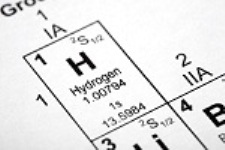Jun 4 2013
Hydrogen is the most abundant element in the universe. The way it responds under extreme pressures and temperatures is crucial to our understanding of matter and the nature of hydrogen-rich planets.
 Periodic table detail of hydrogen by David Freund, courtesy iStockPhoto.
Periodic table detail of hydrogen by David Freund, courtesy iStockPhoto.
New work from Carnegie scientists using intense infrared radiation shines new light on this fundamental material at extreme pressures and reveals the details of a surprising new form of solid hydrogen.
Under normal conditions hydrogen is a gas consisting of diatomic molecules. The hydrogen molecules start to change as the pressure increases. These different forms are called phases and hydrogen has three known solid ones. It has been speculated that at high pressures hydrogen even transforms to a metal, which means it conducts electricity. It could even become a superconductor or a superfluid that never freezes–a completely new and exotic state of matter.
In a new paper published in Physical Review Letters, a team from Carnegie’s Geophysical Laboratory examined the structure, bonding and electronic properties of highly compressed hydrogen using intense infrared radiation.
Using a facility maintained by the Geophysical Laboratory at the National Synchrotron Light Source at Brookhaven National Laboratory, the team found the new form to be stable from about 2.2 million times normal atmospheric pressure and about 80 degrees Fahrenheit to at least 3.4 million times atmospheric pressure and about -100 degrees Fahrenheit.
Their experiments revealed that hydrogen takes a form under these conditions that differs remarkably from its other known structures. The new phase has two very different types of hydrogen molecules in its structure. One type of molecule interacts very weakly with its neighboring molecules--unusual for molecules under this type of very high compression. The other type of molecule bonds with its neighbors, forming surprising planar sheets.
The measurements also show that solid hydrogen under these conditions is on the borderline between a semiconductor, like silicon, and a semimetal, like graphite. The results disprove earlier claims that hydrogen forms a dense atomic metal at these pressures and temperatures.
“This simple element–with only one electron and one proton–continues to surprise us with its richness and complexity when it is subjected to high pressures,” Russell Hemley, Director of the Geophysical Laboratory, said. “The results provide an important testing ground for fundamental theory.”